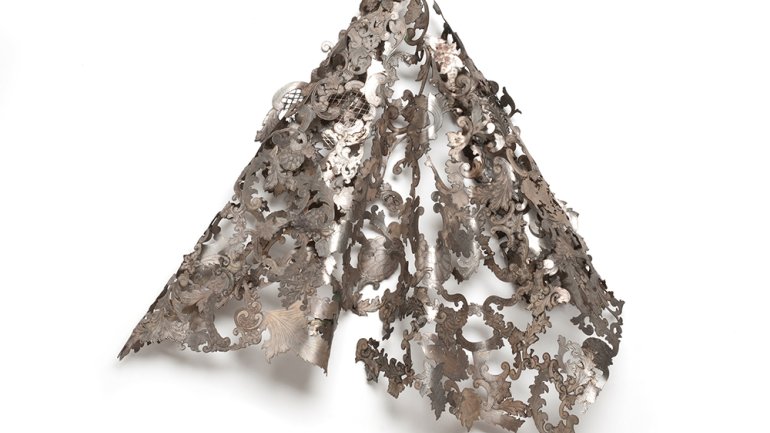Next Generation: Emerging Artist, Jaydan Moore
Next Generation: Emerging Artist, Jaydan Moore
A turning point arrived during Jaydan Moore’s second year of graduate school at the University of Wisconsin-Madison. The artist was creating a series of trophies incorporating found objects, working out ideas about commemoration, memory, and meaning. He discovered that trophies, in fact, originated as table-service ware – think platters, goblets, cups.
It was a revelation – thrift shops are heaped with untapped history – that prompted Moore to delve deeper into everyday objects. “It became clear to me that I no longer wanted to fake the imagery of use and wear, but instead mine the thousands of objects that were already around us,” Moore recalls. “If I hadn’t made that decision to head to the thrift shop, I don’t know if I would be using the silver-plated platters as my material today.”
Today Moore’s work ranges from intricately reconstructed platters to prints of their surfaces, ghostly images that prompt the same kind of unknowable longing as unlabeled tintype portraits. In deconstructing and reassembling, Moore calls on the past while creating something new. As he puts it: “Nothing is lost, only given a new history.”
What’s the most rewarding part of your work?
Taking an object and altering it to give it a new meaning – and the technical challenges that can come with each step. Working with found table-service ware, I want to make sure that what I do to alter the object affects the piece in a positive way. Being able to take something that might have been lost and create a new conversation with the object and its history really motivates me.
What’s challenging?
Making that first decision of how to use the material. As I said, I want to make sure my alterations add to the piece, but that desire can also be debilitating. Sometimes the best course of action is to just cut the material up and see what happens.
Talk about a favorite piece. What makes it significant?
The first piece that comes to mind is Ends. That piece was one of those technical ideas that made sense to me right from the beginning. Making this continuous loop of leftover platter trim spoke so much to me of the silver-plated platters’ own mining of objects from the 18th century – that platters themselves are mass-produced objects trying to replicate a history. Ends was very simple in its idea, but it poignantly hit upon concepts I wanted to discuss.
The other notable piece would be the first print I made with the silver-plated platters. It was that idea that pops in your head that you’re not quite sure about, but instead of letting it go, you take 10 minutes to give it a shot. Every time I have an idea that I’m nervous about, I look back at that moment.
Who have been your biggest supporters? What makes their support valuable?
All of the professors with whom I have worked have been so helpful and supportive. And my family has been so supportive through the years that it is hard to even put into words.
Support, to me, is willingness to have a discussion. The feedback will be challenging and critical. But the professors I’ve had are strong in their statements – and then ready to explain and discuss. They look at what the work is saying to them, listen to what you are trying to say, and push you in the best direction.
Also, a bit of cheering you on and pushing you forward always comes in handy.
How do you define success?
Hitting upon an idea that you want to share, as best and as eloquently as possible.
Also: discussing an idea and touching upon all of its different forms, challenges, faults, and possibilities. The artists whom I see as successful are the ones who have pushed themselves to see an idea from all facets. Their work shows how meaningful an idea is to them, and affects the viewer emotionally and conceptually.
Rewind to the beginning of your career. Have things gone as you planned or hoped?
When I was younger, I had a very focused plan of how my career would go. That has not been how my career has gone at all, but all for the better.
Altering your path to fit the direction that better suits you can be very helpful. That isn’t to say some of those early goals couldn’t come back, but there’s a benefit in knowing the right time for each portion.
Read more Emerging Voices Award profiles.




